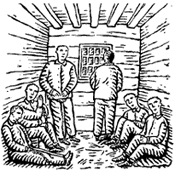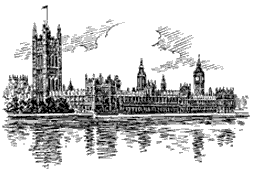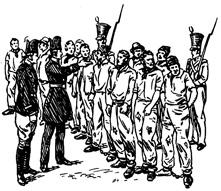 Transportation was a brutal punishment. Few sent to the penal colonies ever returned either because they did not survive the ordeal or because they could not afford the journey home following the end of their sentence.
Transportation was a brutal punishment. Few sent to the penal colonies ever returned either because they did not survive the ordeal or because they could not afford the journey home following the end of their sentence.
Five Martyrs were shipped in appalling conditions to New South Wales, where they were assigned as convict labour to landowners. George Loveless, delayed by illness after the Trial, later went in chains to Tasmania.
They did not return to England until three years after their infamous Trial.
To the hulks in chains
 From their smoke-filled, stinking cell below the Crown Court in Dorchester, five of the convicted men were taken in chains to the prison hulks, York and Leviathan, lying off Portsmouth. George Loveless was too ill to travel but on 5th April 1834 he was declared fit and taken to the York hulk, six weeks later, on 17th May, he sailed aboard the William Metcalfe for Van Diemen’s Land.
From their smoke-filled, stinking cell below the Crown Court in Dorchester, five of the convicted men were taken in chains to the prison hulks, York and Leviathan, lying off Portsmouth. George Loveless was too ill to travel but on 5th April 1834 he was declared fit and taken to the York hulk, six weeks later, on 17th May, he sailed aboard the William Metcalfe for Van Diemen’s Land.
Hulks were condemned ships. There were usually three decks, each containing between 500 and 600 prisoners, issued with coarse convict clothing and fettered with heavy irons riveted to their legs. Disease was rampant. Epidemics of cholera, dysentery and smallpox swept through the packed masses, resulting in a tragic number of deaths on these voyages in such fetid ships.
Penal colonies in Australia
Each of the Martyrs described their experience of transportation in the Horrors of Transportation. George Loveless explained: “To enumerate the various miseries and evils which prisoners are subjected to from the time of landing in the colony until their death, would be utterly impossible; suffice it to say it is dreadful in the extreme, so much so that a person who has never been there can have no idea of it.
James Brine gave more detail:
“I was employed to dig post-holes . . . having walked so far without shoes, my feet were so cut and sore I could not put them to the spade. I got a piece of an iron hoop and wrapped round my foot to tread upon, and for six months . . . I went without shoes, clothes, or bedding, and lay on the bare ground at night. Shortly afterwards I was sent to the pool to wash sheep, and for seventeen days was working up to my breast in water. I thus caught a severe cold, and having told my master that I was very ill, asked him if he would be so good as to give me some-thing to cover me at night, if it were only a piece of horse-cloth. “No,”said he, “I will give you nothing until you are due for it. What would your masters in England have had to cover them if you had not been sent here? I understand it was your intention to have murdered, burnt, and destroyed every thing before you, and you are sent over here to be severely punished, and no mercy shall be shown you.”
Download maps of the Martyrs in Australia and George Loveless in Tasmania.
Read the horrors of transportation as told by the Martyrs themselves in: Horrors of Transportation.
The protest begins
 News of the punishment spread and the fledgling unions knew their very existence was under attack. They had to overturn this sentence and win the right to organise.
News of the punishment spread and the fledgling unions knew their very existence was under attack. They had to overturn this sentence and win the right to organise.
Unknown to the six farm workers on the other side of the world, their case was being taken to Parliament and onto the streets of the capital.
Public pressure resulted in the men being pardoned by the King. Months passed before instructions to free the men reached the Australian authorities.
 “I was employed to dig post-holes . . . having walked so far without shoes, my feet were so cut and sore I could not put them to the spade. I got a piece of an iron hoop and wrapped round my foot to tread upon, and for six months . . . I went without shoes, clothes, or bedding, and lay on the bare ground at night. Shortly afterwards I was sent to the pool to wash sheep, and for seventeen days was working up to my breast in water. I thus caught a severe cold, and having told my master that I was very ill, asked him if he would be so good as to give me some-thing to cover me at night, if it were only a piece of horse-cloth. “No,”said he, “I will give you nothing until you are due for it. What would your masters in England have had to cover them if you had not been sent here? I understand it was your intention to have murdered, burnt, and destroyed every thing before you, and you are sent over here to be severely punished, and no mercy shall be shown you.”
“I was employed to dig post-holes . . . having walked so far without shoes, my feet were so cut and sore I could not put them to the spade. I got a piece of an iron hoop and wrapped round my foot to tread upon, and for six months . . . I went without shoes, clothes, or bedding, and lay on the bare ground at night. Shortly afterwards I was sent to the pool to wash sheep, and for seventeen days was working up to my breast in water. I thus caught a severe cold, and having told my master that I was very ill, asked him if he would be so good as to give me some-thing to cover me at night, if it were only a piece of horse-cloth. “No,”said he, “I will give you nothing until you are due for it. What would your masters in England have had to cover them if you had not been sent here? I understand it was your intention to have murdered, burnt, and destroyed every thing before you, and you are sent over here to be severely punished, and no mercy shall be shown you.”